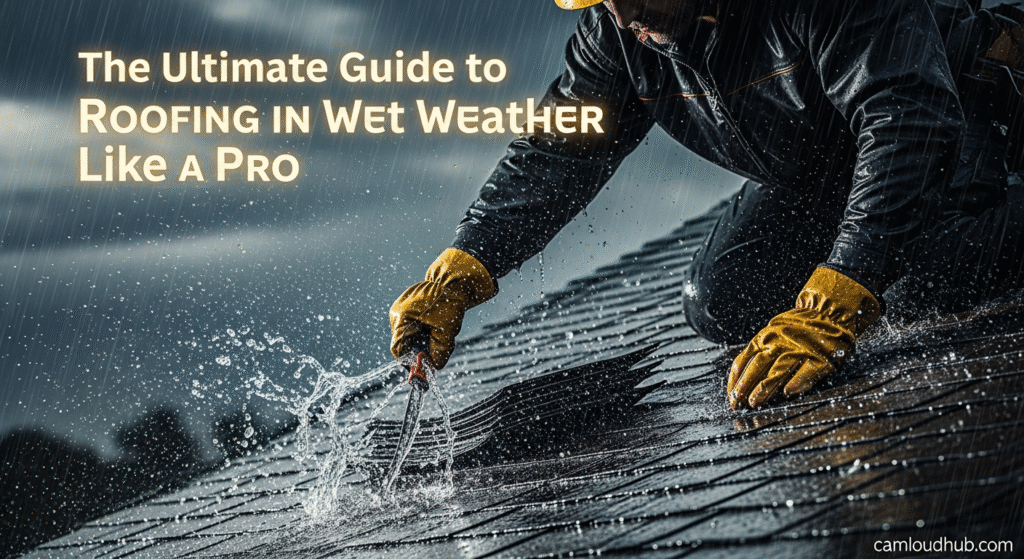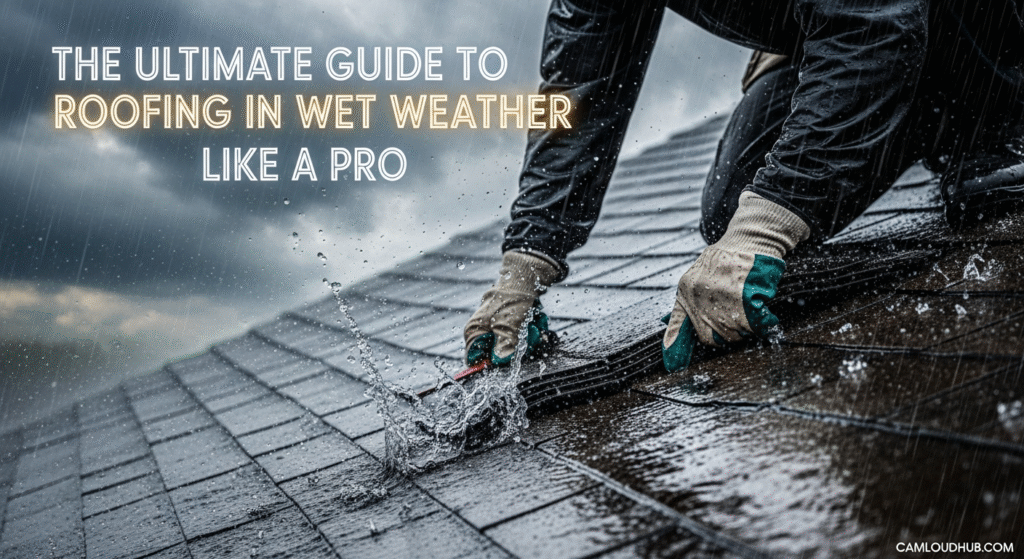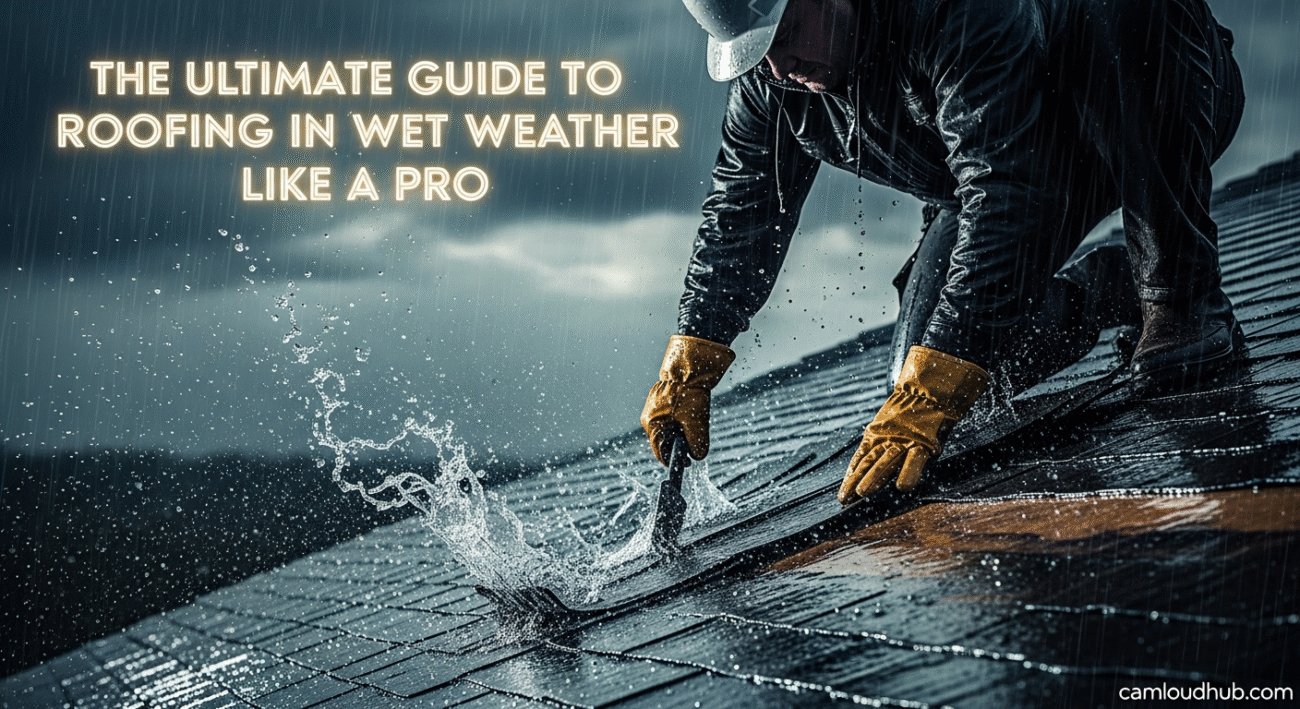The Ultimate Guide to Roofing in Wet Weather Like a Pro
Roofing, by its very nature, is a demanding profession that requires precision, skill, and an unwavering commitment to safety. When the skies open up and rain begins to fall, these demands intensify multifold, transforming routine tasks into complex challenges. Navigating the treacherous conditions of roofing in wet weather is not merely about enduring the rain; it’s about mastering techniques that ensure both the safety of your crew and the integrity of your work.
This comprehensive guide is designed to equip professional roofers with the knowledge and strategies needed to excel in wet weather roofing. We will delve into critical safety protocols, strategic planning, specialized material considerations, and effective emergency response methods. By adopting these expert approaches, you can transform the daunting prospect of rainy day work into an opportunity to showcase unparalleled professionalism and deliver lasting quality, even under adverse conditions.

Understanding the Unique Challenges of Wet Weather Roofing
Working on a roof during or immediately after rainfall introduces a unique set of obstacles that can drastically impact project efficiency and safety. The primary concerns revolve around increased slip hazards, compromised material performance, and logistical complications. Recognizing these challenges is the first step toward developing robust mitigation strategies for any roofing in wet weather scenario.
Rain drastically reduces friction on roof surfaces, making shingles, metal panels, and tiles incredibly slick and dangerous. Reduced visibility due to heavy downpours or overcast skies further compounds the risk, making it harder to spot hazards or maintain clear lines of sight. Additionally, water can adversely affect the adhesion of certain roofing materials and compromise the integrity of exposed underlayments, potentially leading to future issues if not managed properly during rainy weather roofing.
Prioritizing Safety Above All Else
Safety is always paramount in roofing, but its importance is magnified exponentially when working in wet conditions. Even the most experienced professionals are vulnerable to accidents if proper precautions are not rigorously followed. A proactive and unwavering commitment to roofing safety is not just a best practice; it is a non-negotiable requirement for any project undertaken during or around rainfall.
Implementing a comprehensive safety plan tailored for wet weather roofing can prevent injuries, protect your crew, and safeguard your company’s reputation. This includes meticulous hazard assessments, the use of appropriate personal protective equipment, and the installation of robust fall protection systems. Never underestimate the dangers posed by slippery surfaces and unstable footing.
Comprehensive Hazard Assessment and Mitigation
Before any work begins on a wet roof, a thorough hazard assessment is absolutely critical. This evaluation must go beyond standard checks, identifying specific risks amplified by moisture and compromised visibility. Every potential danger, from saturated scaffolding to the presence of standing water, must be carefully considered when performing roofing in wet weather.
Assess the stability of all working surfaces, including ladders, staging, and the roof itself. Look for areas of ponding water that could hide debris or create an unexpected splash hazard. Additionally, inspect the immediate surroundings for power lines or other electrical hazards, as electricity and water present an extremely dangerous combination.
Essential Personal Protective Equipment (PPE) for Rain
The right personal protective equipment (PPE) is your first line of defense against the elements and potential accidents. Standard PPE might not be sufficient for wet weather roofing, necessitating specialized gear designed for waterproof and non-slip performance. Investing in high-quality safety gear specifically for these conditions is a wise financial and safety decision.
Workers should be outfitted with waterproof, breathable outerwear to stay dry and comfortable, preventing hypothermia in colder climates. Non-slip, waterproof footwear with excellent grip is indispensable for maintaining footing on slippery surfaces. Additionally, waterproof gloves ensure a firm grip on tools and materials, while eye protection shields against splashes and reduced visibility.
Implementing Robust Fall Protection Systems
Fall protection systems are a cornerstone of roofing safety, and their proper deployment is even more critical when working on wet roofs. The increased risk of slips means that even short falls can result in serious injury or fatality. Therefore, every crew member must be tied off using appropriate systems when engaged in any form of roofing in wet weather.
This includes full-body harnesses, securely anchored lifelines, and robust guardrail systems where feasible. Ensure all anchor points are inspected for integrity and properly rated for the loads they may bear in wet conditions. Regular training on the correct use and inspection of fall protection equipment is vital to ensure compliance and effectiveness, especially during challenging rainy weather roofing operations.
Strategic Planning and Preparation for Rain Events
Successful roofing in wet weather isn’t about improvisation; it’s about meticulous planning and proactive preparation. A well-thought-out strategy can drastically reduce risks, minimize downtime, and ensure project continuity even when conditions turn unfavorable. Being prepared means anticipating challenges before they arise, allowing for swift and effective responses when necessary.
Developing a detailed rainy weather contingency plan is essential for any professional roofing company. This involves not only predicting the weather but also staging materials, securing the worksite, and establishing clear communication protocols. Proactive measures prevent minor inconveniences from escalating into major problems.
Mastering Weather Forecasting and Monitoring
Accurate weather forecasting is the bedrock of strategic planning for roofing in wet weather. Reliable, real-time weather information allows you to make informed decisions about scheduling, staffing, and project progression. Access to up-to-the-minute radar and hourly forecasts is invaluable for mitigating risks associated with unpredictable rainfall.
Designate a team member responsible for continuously monitoring weather updates throughout the workday. Establish clear thresholds for when work must be paused or completely halted due to adverse conditions such as heavy rain, high winds, or lightning. A clear “go/no-go” policy based on weather parameters protects both your crew and the quality of your wet weather roofing project.
Pre-Emptive Measures and Site Setup
Before rain even begins to fall, several pre-emptive measures can significantly reduce the impact of wet weather on your job site. Proper site setup and preliminary protection are crucial for maintaining efficiency and safeguarding exposed components. These steps exemplify the proactive approach of professional roofing.
Cover exposed areas of the roof and any susceptible building components with heavy-duty tarps or temporary membranes. Ensure these covers are securely fastened to prevent them from blowing away in high winds or collapsing under the weight of accumulated water. Additionally, establish effective drainage systems around the perimeter of the structure to divert water away from critical work areas and foundations, preventing ponding water.
Temporary Waterproofing and Containment Strategies
Implementing effective temporary waterproofing and containment strategies is essential to protect uncompleted roof sections during rain. These temporary solutions bridge the gap between completed and ongoing work, preventing immediate water infiltration. They are critical elements for maintaining the integrity of the building under construction or repair.
Use high-quality synthetic underlayments or specialized temporary roof covers that are designed for quick application and removal. These materials provide a robust barrier against water penetration, safeguarding internal structures and preventing costly moisture damage. Ensure that all seams are properly overlapped and sealed, creating a watertight temporary envelope over areas awaiting final roofing materials.
Protecting Tools and Materials from Moisture Damage
Moisture is the enemy of many roofing tools and materials, leading to rust, degradation, and compromised performance. Protecting your equipment and inventory from rain is not just about extending their lifespan; it’s about ensuring they function safely and effectively when you need them. Proper storage and care are vital for longevity and efficiency.
Store all hand and power tools in watertight containers or covered areas when not in immediate use. Power tools, in particular, should be rated for outdoor or wet conditions, and their electrical connections should be protected from direct exposure to water. All roofing materials, such as shingles, sealants, and underlayments, must be kept dry and elevated off the ground to prevent moisture damage and maintain their adhesive properties and structural integrity.

Professional Techniques and Material Considerations for Wet Conditions
Executing high-quality roofing work in wet conditions demands more than just endurance; it requires specialized roofing techniques and a deep understanding of how various materials react to moisture. Adapting your methods to the environment ensures that the work maintains its durability and performance, even when installed under challenging circumstances. This section focuses on the practical application of expertise during rainfall, highlighting effective waterproofing strategies.
The goal is to minimize exposure to rain for both the roof structure and the installed materials. This often involves working in smaller sections, relying on temporary seals, and having an accelerated workflow when brief dry spells occur. Mastering these techniques is a hallmark of a truly professional roofing operation.
Working with Different Roofing Materials in the Rain
The approach to roofing in wet weather varies significantly depending on the type of material being installed or repaired. Each material presents unique challenges and requires specific adaptations to ensure proper application and long-term performance. Understanding these nuances is crucial for delivering quality.
Asphalt shingles, for instance, can be challenging because their self-sealing adhesive strips may not activate properly in cold, wet conditions. Metal roofing can become extremely slippery and requires enhanced traction and careful handling. Tile roofs are fragile and can become even more brittle or slippery when wet, demanding extreme caution and specialized foot placement. Flat roofs require meticulous attention to drainage to prevent ponding water during and after installation.
Effective Temporary and Emergency Roof Repair
When a leak occurs during a rain event, immediate and effective action is paramount to prevent extensive interior damage. Emergency roof repair focuses on stopping the immediate water intrusion, even if the solutions are temporary. These quick fixes are critical bridges to more permanent long-term solutions.
Having a dedicated kit for temporary roof repairs on hand is essential. This kit should include items like heavy-duty tarps, roofing cement, sealants designed for wet applications, and waterproof patching materials. The goal is to rapidly identify the source of the leak, create a seal, and divert water away from vulnerable areas, protecting the property from further water intrusion and moisture damage.
Rapid Leak Identification and Isolation
Identifying an active leak precisely during a downpour can be challenging, but it is the first critical step in effective emergency roof repair. Water often travels along internal structures before manifesting, making its entry point difficult to pinpoint. However, with systematic approaches, you can significantly narrow down the search.
Start by inspecting the interior for water trails, stains, or drips, and then trace them back to the likely entry point. On the exterior, look for obvious breaches, displaced roofing materials, or areas of ponding water. Once identified, isolate the leak by placing buckets or temporary catchments to prevent further damage, and then prepare for a quick fix.
Executing a Durable Temporary Patch
Once a leak is located and isolated, the next step is to apply a durable temporary patch that can withstand ongoing rain until permanent repairs can be made. This step is about stabilization and protection, buying time for better weather conditions. The selection of materials is crucial for the effectiveness of the patch.
Clean the area around the leak as thoroughly as possible, even in wet conditions, to ensure better adhesion. Apply a waterproof roofing cement or caulk specially formulated for wet surfaces around the damaged area. Overlay this with a durable patch, such as a rubberized membrane or heavy-gauge plastic sheeting, extending well beyond the damaged spot. Secure the patch firmly with fasteners or additional sealant to create a watertight seal, effectively performing temporary roof repairs.
Post-Rain Procedures and Quality Assurance
The work isn’t truly done once the rain stops and the temporary fixes are in place. A critical phase of roofing in wet weather involves meticulous post-rain procedures and comprehensive quality assurance. This ensures that no hidden damage occurred during the rainfall and that the temporary repairs hold until permanent work can commence.
Thorough inspection, proper drying, and careful assessment for any lasting impacts are essential steps to guarantee the longevity and integrity of the roof. This phase is crucial for transitioning from quick fixes to long-term solutions and upholding the reputation of professional roofing. Ignoring these steps can lead to severe moisture damage and structural issues down the line.
Thorough Post-Rainfall Inspections
Once the weather clears, conducting a detailed roof inspection is non-negotiable. This inspection should assess not only the area of the original issue but also the surrounding roof sections and the interior of the building for any new or exacerbated damage. The goal is to identify and address any problems before they become more significant.
Look for displaced shingles, loose flashing, or any signs of water penetration into the underlying structure. Pay close attention to water flow paths, checking for areas where ponding water might have occurred or where debris has accumulated. Document all findings with photographs and detailed notes, creating a comprehensive record of the roof’s condition.
Ensuring Proper Drying and Addressing Moisture
Even if a temporary patch held, residual moisture can still be a significant problem, potentially leading to mold, rot, or compromised building materials. Effective post-rain drying protocols are crucial for preventing long-term moisture damage and ensuring structural integrity. This step is often overlooked but is vital for a healthy building.
Implement strategies to promote air circulation and facilitate drying in any areas that may have become damp. Use industrial fans or dehumidifiers in interior spaces where water penetration occurred. Ensure that all water-saturated insulation or building materials are removed and replaced to prevent fungal growth and maintain the building’s thermal performance and structural integrity.
Detailed Checks for Water Penetration
Beyond visible signs, it’s essential to perform detailed checks for subtle water penetration that might not be immediately obvious. Water can seep into unseen cavities, leading to insidious damage over time. These checks ensure that no hidden moisture damage is left unaddressed.
Utilize moisture meters to check the water content of various building materials, including insulation, drywall, and wood framing. Inspect attic spaces and crawl areas thoroughly for any signs of water intrusion or dampness. These proactive measures help confirm that your protective measures were effective and that no water has compromised the building’s interior.
Finalizing Work and Long-Term Protection
With all inspections complete and moisture concerns addressed, the final phase involves transitioning from temporary repairs to permanent, durable solutions. This is where the long-term solutions are implemented, ensuring the roof’s robust performance for years to come. This step reinforces the commitment to quality and client satisfaction.
Complete all necessary permanent repairs with the highest quality roofing materials and roofing techniques. This includes replacing damaged shingles, sealing all flashing, and ensuring a comprehensive waterproofing layer is in place. Conduct a final comprehensive roof inspection to confirm the integrity of all work and apply any additional protective measures to enhance the roof’s resilience against future inclement weather.
Conclusion
Mastering roofing in wet weather is a defining characteristic of a truly professional roofing contractor. It demands a holistic approach that meticulously integrates safety, strategic planning, specialized techniques, and rigorous post-production quality assurance. By diligently adhering to these principles, roofers can not only safeguard their teams and maintain project timelines but also deliver exceptional craftsmanship that stands resilient against even the harshest of elements.
The ability to operate effectively and safely during rainy weather roofing scenarios is a testament to skill and dedication, building immense trust with clients and solidifying a reputation for excellence. Embrace the challenges of wet weather roofing as opportunities to demonstrate unparalleled expertise, cementing your status as a leader in the industry. Through continuous learning, meticulous preparation, and unwavering commitment to safety, professional roofers can confidently navigate the complexities of inclement weather, delivering durable, high-quality roofs every time.


